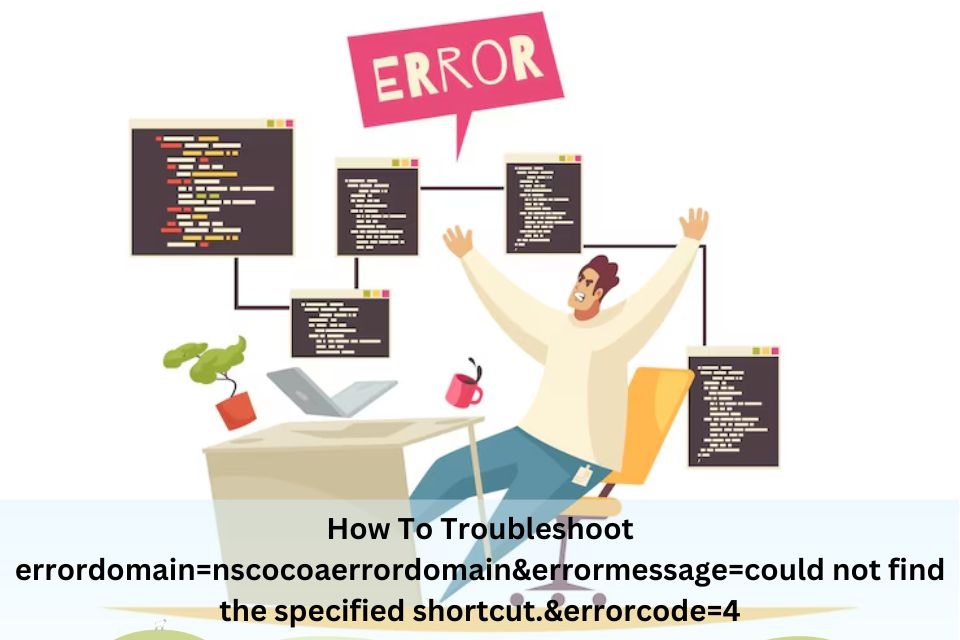Errordomain=Nscocoaerrordomain&errormessage=Could Not Find The Specified Shortcut.&errorcode=4: How To Troubleshoot The Error
“Errordomain=nscocoaerrordomain&errormessage=could not find the specified shortcut.&errorcode=4” can be irritating for iOS and macOS users. It often appears when an application or system fails to locate a necessary shortcut, which halts its proper function. While this issue may seem difficult, it is generally fixable with a series of troubleshooting steps. This article will guide you through understanding why this error occurs, its consequences, and how to troubleshoot it effectively.
What Is errordomain=nscocoaerrordomain&errormessage=could not find the specified shortcut.&errorcode=4?
“Errordomain=nscocoaerrordomain&errormessage=could not find the specified shortcut.&errorcode=4” generally indicates a problem within the Apple ecosystem, particularly related to the Cocoa framework, which supports macOS and iOS apps. This error means the system couldn’t find a required shortcut or resource for an application to function. The “ErrorCode=4” helps identify the issue, often linked to incorrect file paths, missing resources, or corruption in the app’s structure.
What Made This Error Happen?
Missing Or Deleted Shortcut
The most straightforward cause is that the application attempts to access a shortcut that no longer exists. This can happen if a file, folder, or command linked to the shortcut has been moved, deleted, or renamed. When the application cannot find the specified shortcut, this error is triggered.
Corrupted Files
Files essential to the application’s functionality might become corrupted. This could happen during a software update, a failed installation, or even through sudden system shutdowns. When these corrupted files are associated with shortcuts, it causes the system to fail to recognize the required shortcut, leading to this error.
Incorrect Permissions
Sometimes, the application might not have the necessary permissions to access the specific file or directory linked to the shortcut. On macOS or iOS, file permissions play a vital role in application functionality. If the user or system changes the access permissions, the application could lose the ability to interact with the shortcut, causing the error.
Broken Or Invalid Registry Entries (on macOS)
For systems that involve registry keys, broken or invalid registry entries can also be a cause. These registry entries act as references for the system and applications. When a registry entry related to the shortcut is invalid or corrupted, the system cannot locate the necessary resource, thus triggering the error.
Software Bugs Or Glitches
Applications occasionally have bugs or glitches that can cause shortcuts to be improperly created, linked, or accessed. These bugs may result from poor coding practices, incomplete software updates, or conflicts with other installed software.
Malware Or Virus Infection
Although less common on macOS, a malware or virus infection could interfere with how the system or an application accesses shortcuts. Malicious software can delete, corrupt, or block access to important files and shortcuts, leading to the error being displayed.
Consequences Of This Error
- Application Failure: The program might not launch or may freeze midway, limiting functionality.
- Data Loss: Corruption or removal of vital files could lead to the loss of unsaved data, especially if the application was handling critical tasks.
- System Instability: Repeated encounters with this error could indicate a deeper issue with system files, potentially destabilizing the operating system.
- Reduced Productivity: Users unable to access the necessary application or function may experience delays in completing tasks.
How To Troubleshoot This Error?
Check And Restore The Shortcut
- Navigate to the location where the shortcut or file is supposed to be. If it’s missing, try restoring it from a backup if available.
- If the file has been accidentally deleted, use a file recovery tool like EaseUS Data Recovery or Time Machine (macOS) to retrieve the missing file.
Reinstall The Application
- If restoring the file doesn’t work, uninstall the application and reinstall it. This will help restore any missing or corrupted files required by the program.
- You can uninstall by dragging the application to the Trash (macOS), then reinstall the latest version from the App Store or the developer’s site.
Perform A System Update
- Check if there are any available updates for your macOS or iOS system. System updates often include patches that can resolve compatibility and performance issues.
- To update, go to System Preferences > Software Update on macOS or Settings > General > Software Update on iOS.
Check File Permissions
- Sometimes, the application may not have the necessary permissions to access a specific file. Check file permissions by right-clicking the file and selecting Get Info, then adjusting the Sharing & Permissions section to allow proper access.
Run Disk Utility
- If you suspect file corruption, you can use Disk Utility on macOS to repair your disk. Open Disk Utility, select your disk, and choose the First Aid option to check for and repair any disk issues.
Use Antivirus Software
- If malware or viruses are suspected to be interfering with system files, run a full scan using a trusted antivirus tool like Norton or Avast. This can help remove any malicious software affecting the system.
Conclusion
Though frustrating, the “errordomain=nscocoaerrordomain&errormessage=could not find the specified shortcut.&errorcode=4” error is manageable with proper troubleshooting steps. From restoring files to reinstalling applications and checking for system updates, several methods can resolve this issue. Regularly updating your system, keeping backups, and maintaining clean permissions can help prevent similar errors from occurring in the future. Professional technical support may be necessary to diagnose deeper system issues if all else fails.
FAQs
- Can I fix this error without reinstalling the application?
Yes, sometimes restoring the missing shortcut or adjusting file permissions can fix the error without reinstalling the application.
- Why does this error keep happening after a system update?
System updates may cause compatibility issues, especially if applications rely on outdated shortcuts or files. Reinstalling the app or checking for updates can help.
- What tools can I use to recover deleted shortcuts?
You can use file recovery tools like EaseUS Data Recovery or macOS Time Machine to restore deleted shortcuts.
- Is it safe to use Disk Utility to fix file corruption?
Yes, Disk Utility’s First Aid option is a safe tool for diagnosing and fixing basic file system issues on macOS.





